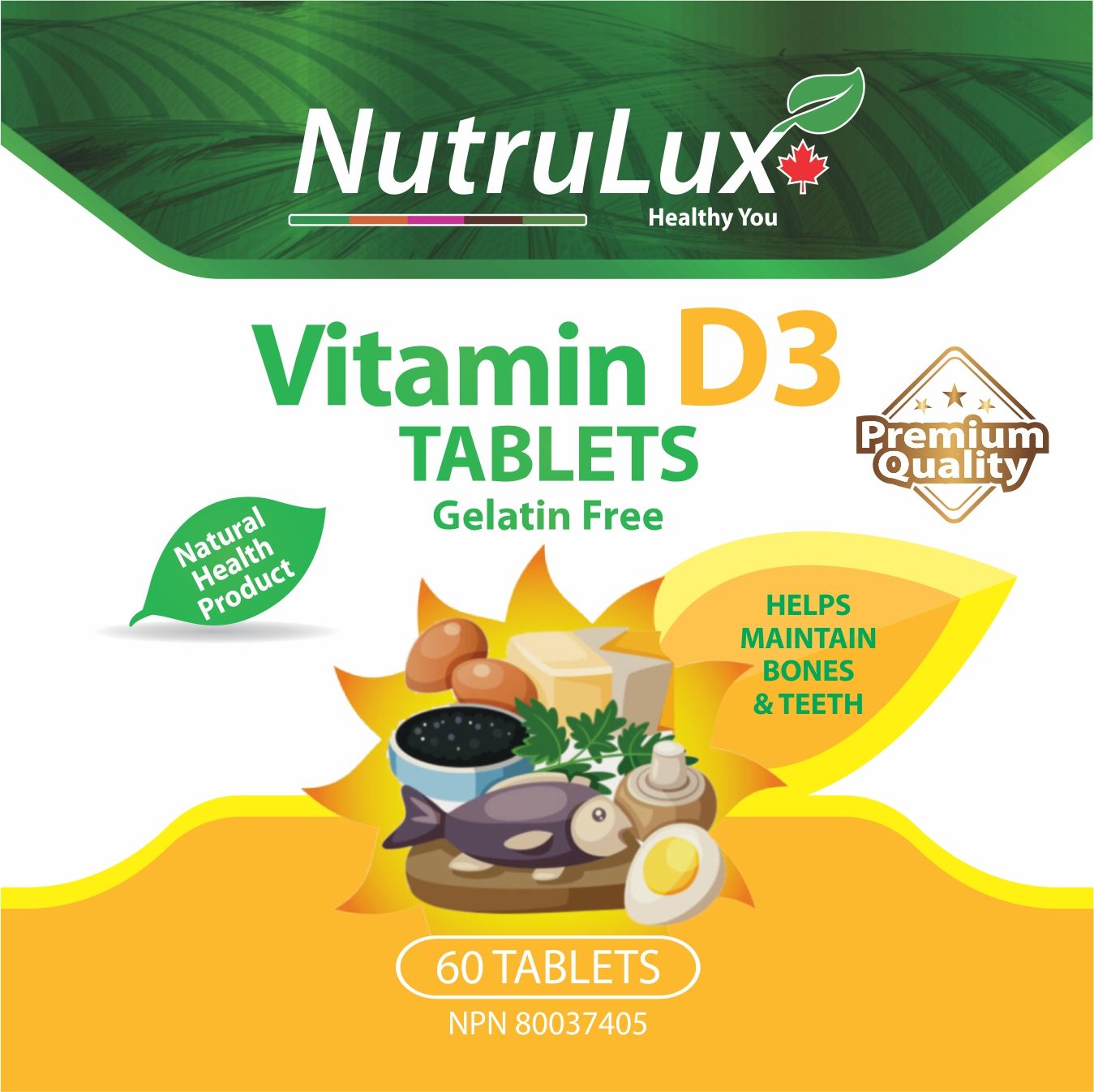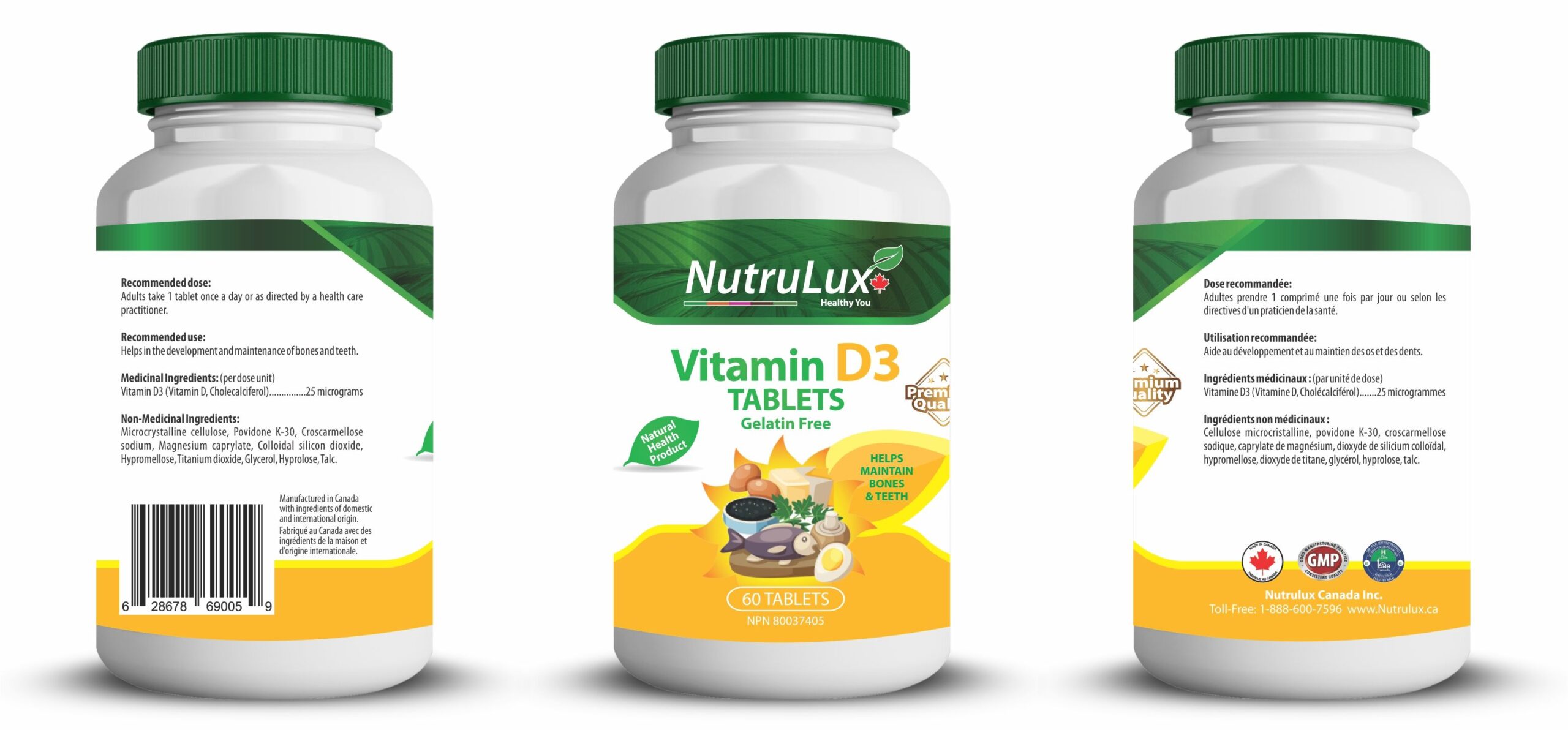
Vitamin D3 (25 mg Vitamin D3 ) Halal Gelatin Free Tablets
$14.99
Vitamin D is a fat-soluble vitamin important for bone health. For those low in this nutrient, increasing intake may also reduce depression and improve strength. Your skin produces vitamin D when exposed to sunlight. Foods like fatty fish, fish oil, and liver also contain vitamin D — as well as certain fortified foods and supplements. Deficiency is fairly common due to limited sunlight exposure and a small selection of rich dietary sources. If you don’t spend much time in the sun and rarely eat fatty fish, consider supplementing. Getting enough vitamin D can go a long way to boosting your health.
Recommended dose:
Adults take 1 tablet once a day or as directed by a health care practitioner.
Recommended use:
Helps in the development and maintenance of bones and teeth.

Buy 1 & Get 1 Free
Description
Vitamin D
Vitamin D is completely different than most other vitamins. In fact, it’s a steroid hormone produced from cholesterol when your skin is exposed to the sun. For this reason, vitamin D is often referred to as “the sunshine vitamin.” However, sun exposure rarely provides adequate vitamin D, making it necessary to obtain it from supplements or your diet. Yet only a handful of foods contain significant amounts of this crucial vitamin, and deficiency is very common. In fact, around 41.6% of the U.S. population is deficient. This article explains everything you need to know about vitamin D.
What Is Vitamin D?
- Vitamin D is a fat-soluble vitamin, meaning that it dissolves in fats and oils and can be stored in your body for a long time. Two main dietary forms exist (5Trusted Source):
- Vitamin D3 (cholecalciferol). Found in some animal foods, like fatty fish and egg yolks.
- Vitamin D2 (ergocalciferol). Found in some plants, mushrooms, and yeasts.
- Of the two, D3 (cholecalciferol) seems to be almost twice as effective at increasing blood levels of vitamin D as D2 (ergocalciferol) (6Trusted Source,
What Does It Do in Your Body?
Vitamin D needs to undergo two conversion steps to become active (8Trusted Source, 9Trusted Source). First, it is converted to calcitriol, or 25(OH)D, in your liver. This is the storage form of the vitamin. Second, it is converted to calcitriol, or 1,25(OH)2D, mostly in your kidneys. This is the active, steroid-hormone form of vitamin D. Calcitriol interacts with the vitamin D receptor (VDR), which is found in almost every single cell in your body. When the active form of vitamin D binds to this receptor, it turns genes on or off, leading to changes in your cells. This is similar to how most other steroid hormones work. Vitamin D affects various cells related to bone health. For example, it promotes the absorption of calcium and phosphorus from your gut. But scientists have recently discovered that it also plays roles in other areas of health, such as immune function and protection against cancer.
Symptoms of Deficiency
Vitamin D deficiency is one of the most common nutrient deficiencies. Some people are at a greater risk than others. In the United States, 41.6% of the total population is deficient, although minorities fare worse — 82.1% and 69.2% of blacks and Hispanics are deficient, respectively. Additionally, older adults are at a much greater risk of being deficient. Those who have certain diseases are also very likely to be deficient. One study showed that 96% of people who had experienced heart attacks were low in vitamin D. Overall, vitamin D deficiency is a silent epidemic. The symptoms are usually subtle and may take years or decades to surface. The most well-known symptom of vitamin D deficiency is rickets, a bone disease common in children in developing countries. Rickets has been mostly eliminated from Western countries because of the fortification of some foods with vitamin D. Deficiency is also linked to osteoporosis, reduced mineral density, and increased risk of falls and fractures in older adults. What’s more, studies indicate that people with low vitamin D levels have a much greater risk of heart disease, diabetes (types 1 and 2), cancer, dementia, and autoimmune diseases like multiple sclerosis. Finally, vitamin D deficiency is linked to a reduced life expectancy. That said, it’s unclear whether deficiency contributes to these diseases or whether people with low levels are just more likely to get them.
Potential Health Benefits
Reduced risk of osteoporosis, falls, and fractures. Higher doses of vitamin D can help prevent osteoporosis, falls, and fractures in older adults. Better strength. Vitamin D can increase physical strength in both upper and lower limbs. Cancer prevention. Vitamin D may help prevent cancer. One study noted that 1,100 IU per day — alongside calcium — reduced cancer risk by 60%. Depression management. Studies show that vitamin D may ease symptoms in people with clinical depression. Reduced risk of type 1 diabetes. One study in infants linked 2,000 IU of vitamin D per day to a 78% reduced risk of type 1 diabetes. Improved mortality. Some studies suggest that vitamin D reduces people’s risk of dying during the study periods, indicating that it may help you live longer. However, many of these results are preliminary. According to a recent review, more evidence is necessary to confirm many of these benefits. Although adequacy is measured at 20 ng/ml, many health experts believe that people should aim for blood levels higher than 30 ng/ml for optimal health and disease prevention. Additionally, many believe that the recommended intake is far too low, and that people need much more to reach optimal blood levels. According to the U.S. National Academy of Medicine, the safe upper limit is 4,000 IU (100 mcg) per day. Vitamin D3 supplements appear to be more effective at raising vitamin D levels than D2 supplements.
What Happens if You Take Too Much?
It is a myth that it is easy to overdose on vitamin D. Vitamin D toxicity is very rare and only happens if you take very high doses for extended periods. The main symptoms of toxicity include confusion, lack of concentration, drowsiness, depression, vomiting, abdominal pain, constipation, and high blood pressure.
























